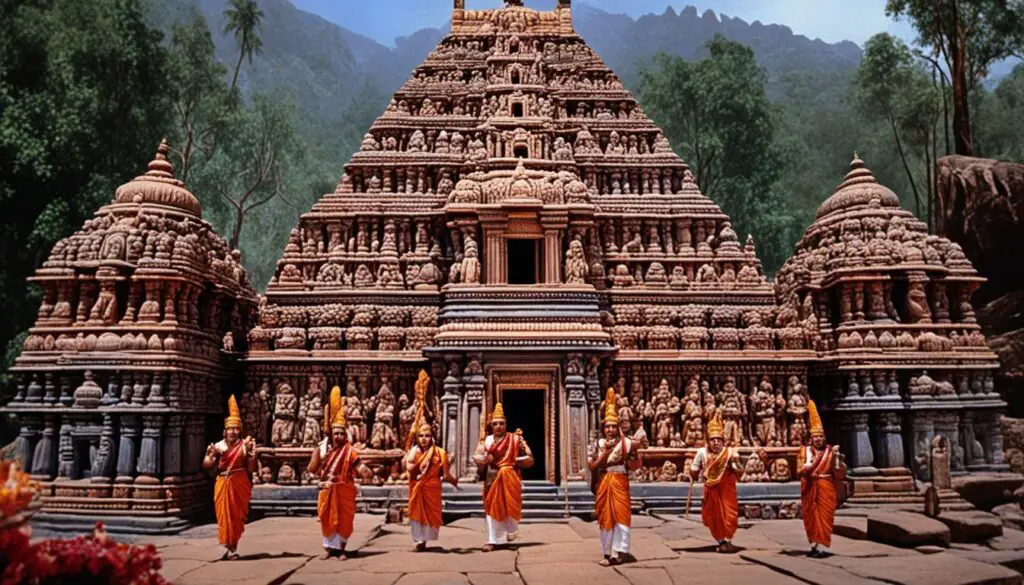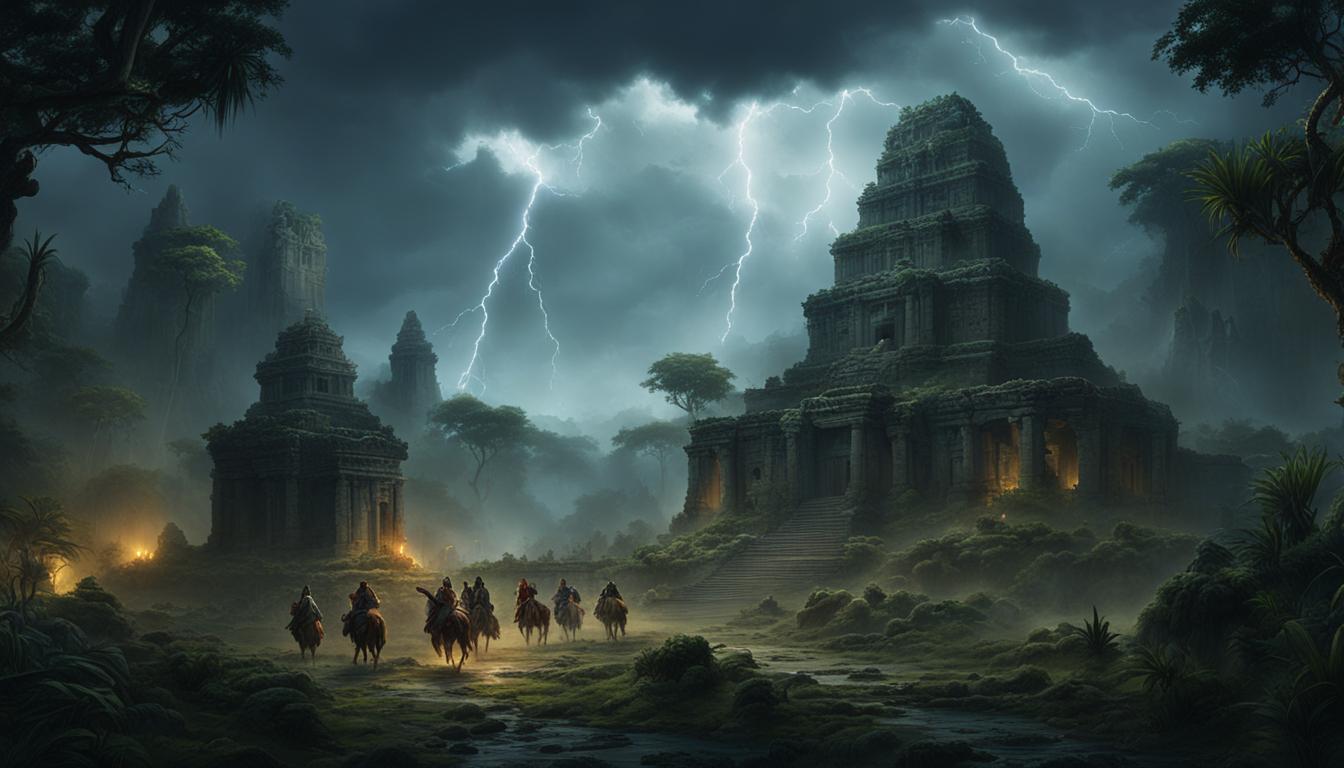The Kalabhras of the Sangam Age in India have long been shrouded in mystery and speculation among historians. This ancient Indian civilization has captivated the imagination with its unique history and cultural influence. Delving into the history of Kalabhras can provide valuable insights into the rich tapestry of India’s past.
Key Takeaways:
- The Kalabhras were an enigmatic dynasty that ruled during the Sangam Age in ancient India.
- Their coins with hieroglyphic symbols provide clues to their unique cultural identity.
- It is believed that the Kalabhras spoke Prakritam and may have incorporated this language into their coin inscriptions.
- The name ‘Kalabhras’ is derived from the word ‘karabha’, meaning ‘elephant’ in ancient times.
- The Kalabhras patronized Hinduism, Buddhism, and Jainism, with a focus on the worship of the god Skanda or Subramanya.
The Kalabhras in the Sangam Age
The Sangam Age in ancient Tamil Nadu witnessed the rise of a powerful dynasty known as the Kalabhras. This period marked a significant chapter in the region’s history, characterized by the Kalabhras’ emergence as a dominant force. The Sangam literature provides invaluable insights into their influence and impact on the political landscape of the time.
According to historical accounts, the Kalabhras overthrew the established Chera, Chola, and Pandya kingdoms, solidifying their rule over Tamil Nadu. This period of Kalabhra rule is often referred to as an “interregnum” or a “historical night” due to the scarcity of comprehensive historical records. The lack of detailed information has made it challenging for historians to ascertain the exact chronology and duration of Kalabhra rule.
The decline of the Roman Empire and its trade with the East, coupled with the subsequent decline of the Chera Empire, are believed to have contributed to the rise of the Kalabhras. This gave them the opportunity to establish their supremacy over Tamil Nadu during the Sangam Age.
“The Kalabhras emerged as a potent force in ancient Tamil Nadu during the Sangam Age, overthrowing the established kingdoms and imposing their rule over the region.”
The Kalabhras’ rule marked a significant shift in the political structure of ancient Tamil Nadu, with their dominance shaping the trajectory of the region’s history. However, due to the fragmented nature of historical records, the specific details of their reign remain obscure.
The Impact of Kalabhras on Tamil Nadu
Despite the limited historical evidence, it is widely agreed that the Kalabhras left a lasting influence on the culture and religion of ancient Tamil Nadu. Through their patronage of Hinduism, Buddhism, and Jainism, the Kalabhras played a role in fostering religious pluralism in the region.
The worship of deities like Skanda or Subramanya, heavily promoted by the Kalabhras, significantly impacted the religious practices and iconography of subsequent dynasties that arose after their downfall. This religious influence can be observed in various artistic and architectural manifestations found in Tamil Nadu today.
The Kalabhras’ rise and subsequent fall set the stage for the emergence of new dynasties, such as the Pallavas and Kadambas, who went on to shape the political landscape of South India. The Kalabhras laid the foundation for these dynasties, leaving an indelible mark on the history and civilization of Tamil Nadu.

Key Points:
- The Kalabhras emerged as a dominant force during the Sangam Age in ancient Tamil Nadu.
- They overthrew the established Chera, Chola, and Pandya kingdoms.
- Historical records during the Kalabhra rule remain limited, leading to the term “interregnum.”
- The decline of the Roman Empire and the Chera Empire contributed to the rise of the Kalabhras.
- Their patronage of Hinduism, Buddhism, and Jainism had a lasting impact on the region’s religious practices.
- The worship of deities like Skanda or Subramanya influenced subsequent dynasties and their iconography.
| Key Dynasty | Period | Significance |
|---|---|---|
| Kalabhras | Sangam Age | Emergence as a dominant force in Tamil Nadu |
| Pallavas | 3rd – 9th century CE | Overthrow of the Kalabhras and subsequent rule in South India |
| Kadambas | 4th – 6th century CE | Rise to power after the decline of the Kalabhras |
The Kalabhras and their Influence
The Kalabhras played a significant role in shaping the political history of South India. Their rule was eventually challenged and overthrown by the Pallavas, who emerged as a prominent dynasty in the region. The Pallavas and the Kadambas were two key dynasties that rose to power after the decline of the Kalabhras.
The precise nature of the Kalabhras’ influence on these dynasties and the political landscape remains a topic of debate among historians. However, it is believed that the Kalabhras’ patronage of Hinduism, Buddhism, and Jainism had a lasting impact on the cultural and religious practices of the region. Additionally, the Kalabhras’ focus on the worship of deities like Skanda or Subramanya influenced the subsequent dynasties’ religious practices and iconography.
To understand the influence of the Kalabhras on South India, we can explore their interactions with the Pallavas and Kadambas in more detail. The Pallavas, led by Mahendravarman I, managed to overthrow the Kalabhra rule and established their dynasty around the 4th century CE. They went on to become one of the most powerful dynasties in South India, known for their architectural wonders and patronage of the arts.
The Kadambas, on the other hand, rose to prominence in the Western Ghat region of South India after the decline of the Kalabhras. They were known for their unique style of architecture and their contributions to Kannada literature. The Kadambas worked towards revitalizing the cultural and religious practices that were impacted by the Kalabhras’ rule.
Overall, the Kalabhras’ impact on South India was substantial, and their influence can be seen in the political, cultural, and religious developments that followed their rule. While many questions remain unanswered, the Kalabhras left an indelible mark on the history of South India, paving the way for the rise of the Pallavas, Kadambas, and subsequent dynasties.

Notable Dynasty: Pallavas
| Period | Key Rulers | Notable Contributions |
|---|---|---|
| 4th to 9th century CE | Mahendravarman I, Narasimhavarman I | – Construction of iconic rock-cut temples like Mahabalipuram – Promotion of Sanskrit and Tamil literature – Established strong maritime trade connections – Patronage of the arts and architecture |
Notable Dynasty: Kadambas
| Period | Key Rulers | Notable Contributions |
|---|---|---|
| 4th to 6th century CE | Mayurasharma, Kakusthavarma | – Development of Kannada language and literature – Promoted regional architecture and sculpture – Revival of cultural practices impacted by the Kalabhras |
Conclusion
The Kalabhras hold a significant place in the history of South India, particularly during the Sangam Age. While much about this enigmatic dynasty remains unknown, their coins and cultural impact provide valuable clues to their existence and influence.
The Kalabhras’ rule during the interregnum period disrupted the established political order of the Chera, Chola, and Pandya kingdoms. Their patronage of Hinduism, Buddhism, and Jainism, along with their focus on the worship of deities like Skanda or Subramanya, left a lasting impact on the religious and cultural practices of the subsequent dynasties.
Although the Kalabhras were eventually overthrown by the Pallavas and Kadambas, their historical significance cannot be overlooked in understanding the ancient Indian civilization in South India. Their era marked a transitional phase in the region’s history and contributed to the formation of the Pallava and Kadamba dynasties, who, in turn, shaped the political landscape of South India.
FAQ
Who were the Kalabhras?
The Kalabhras were a mysterious group that emerged as a dominant force during the Sangam Age in ancient Tamil Nadu, India.
What is the Sangam Age?
The Sangam Age refers to a period in ancient Tamil Nadu where the Tamil literature known as Sangam literature flourished.
Did the Kalabhras overthrow other kingdoms?
Yes, the Kalabhras are believed to have overthrown the ancient Chera, Chola, and Pandya kingdoms during their rule.
How long did the Kalabhras rule?
The exact duration of the Kalabhras’ rule is uncertain due to the lack of comprehensive historical records.
Who overthrew the Kalabhras?
The Pallavas eventually challenged and overthrew the Kalabhras, becoming a prominent dynasty in the region.
What was the Kalabhras’ influence on the Pallavas and Kadambas?
The exact nature of the Kalabhras’ influence on subsequent dynasties remains a topic of debate among historians, but it is believed that their patronage of Hinduism, Buddhism, and Jainism had a lasting impact on the cultural and religious practices of these dynasties.
What was the significance of the Kalabhras’ focus on the worship of deities like Skanda or Subramanya?
The Kalabhras’ emphasis on the worship of deities like Skanda or Subramanya influenced the religious practices and iconography of the subsequent dynasties in South India.
What is the historical significance of the Kalabhras?
The Kalabhras hold a significant place in the history of South India, particularly during the Sangam Age. Their rule disrupted the established political order, and their cultural impact left a lasting influence on the religious and cultural practices of the subsequent dynasties.
